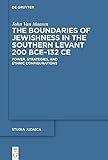The Boundaries of Jewishness in the Southern Levant 200 BCE–132 CE : Power, Strategies, and Ethnic Configurations / John Van Maaren.
Material type: TextSeries: Studia Judaica : Forschungen zur Wissenschaft des Judentums ; 118Publisher: Berlin ; Boston : De Gruyter, [2022]Copyright date: ©2022Description: 1 online resource (XVIII, 316 p.)Content type:
TextSeries: Studia Judaica : Forschungen zur Wissenschaft des Judentums ; 118Publisher: Berlin ; Boston : De Gruyter, [2022]Copyright date: ©2022Description: 1 online resource (XVIII, 316 p.)Content type: - 9783110787382
- 9783110787481
- 9783110787450
- DS135.L4 V36 2022
- DS135.L4 V36 2022
- online - DeGruyter
- Issued also in print.
| Item type | Current library | Call number | URL | Status | Notes | Barcode | |
|---|---|---|---|---|---|---|---|
 eBook
eBook
|
Biblioteca "Angelicum" Pont. Univ. S.Tommaso d'Aquino Nuvola online | online - DeGruyter (Browse shelf(Opens below)) | Online access | Not for loan (Accesso limitato) | Accesso per gli utenti autorizzati / Access for authorized users | (dgr)9783110787450 |
Browsing Biblioteca "Angelicum" Pont. Univ. S.Tommaso d'Aquino shelves, Shelving location: Nuvola online Close shelf browser (Hides shelf browser)
Frontmatter -- Preface -- Contents -- Figures and Tables -- Abbreviations -- 1 Introduction and Methodology -- 2 Jewishness under the Seleucids (200–129 BCE) -- 3 Jewishness under the Hasmoneans (129–63 BCE) -- 4 Jewishness under the Romans (63 BCE–132 CE) -- 5 Conclusion -- 6 Appendix 1 -- Bibliography -- Index of subjects -- Index of ancient sources -- Index of modern authors
restricted access online access with authorization star
http://purl.org/coar/access_right/c_16ec
Recent research has considered how changing imperial contexts influence conceptions of Jewishness among ruling elites (esp. Eckhardt, Ethnos und Herrschaft, 2013). This study integrates other, often marginal, conceptions with elite perspectives. It uses the ethnic boundary making model, an empirically based sociological model, to link macro-level characteristics of the social field with individual agency in ethnic construction. It uses a wide range of written sources as evidence for constructions of Jewishness and relates these to a local-specific understanding of demographic and institutional characteristics, informed by material culture. The result is a diachronic study of how institutional changes under Seleucid, Hasmonean, and Early Roman rule influenced the ways that members of the ruling elite, retainer class, and marginalized groups presented their preferred visions of Jewishness. These sometimes-competing visions advance different strategies to maintain, rework, or blur the boundaries between Jews and others. The study provides the next step toward a thick description of Jewishness in antiquity by introducing needed systematization for relating written sources from different social strata with their contexts.
Issued also in print.
Mode of access: Internet via World Wide Web.
In English.
Description based on online resource; title from PDF title page (publisher's Web site, viewed 02. Mai 2023)









